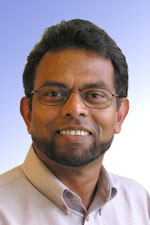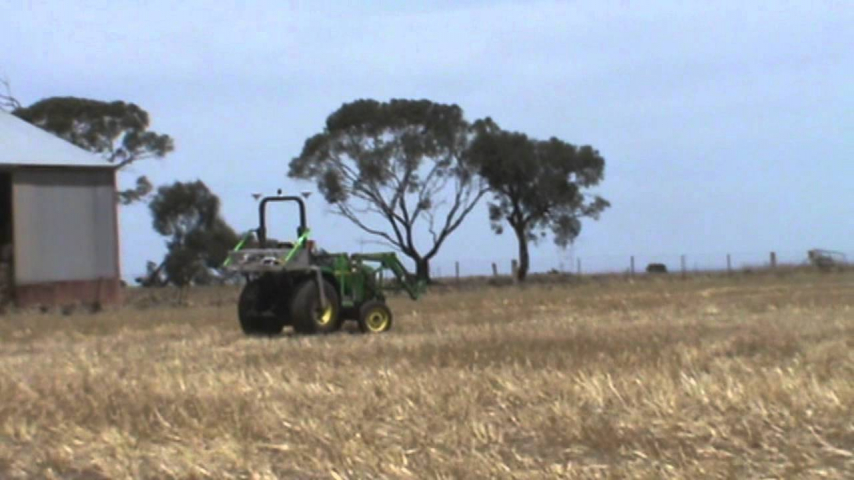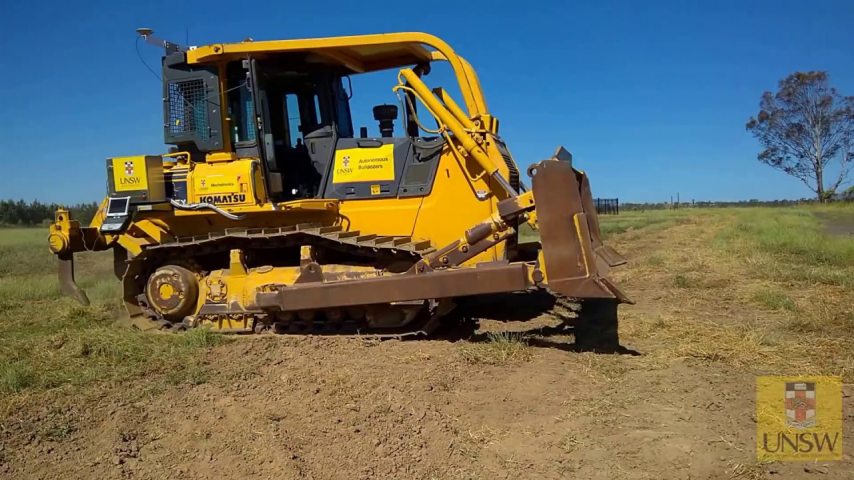
My Expertise
Industrial automation; automatic controls; robotics; computer controlled systems; microlens fabrication on optical fibres, virtual interfaces for wheelchairs.
Fields of Research (FoR)
Autonomous Vehicles, Control Systems, Robotics and Automation, Manufacturing Robotics and Mechatronics (excl. Automotive Mechatronics)SEO tags
Biography
Associate Professor Jayantha Katupitiya is from the School of Mechanical and Manufacturing Engineering. His research interests include:
Autonomous Large Vehicle Guidance
The research in this area is directed at automating large scale ground vehicles that operate on the agricultural fields and their autonomous navigation to conform to traversing specifications. They are, in general, articulated vehicle systems, in which a large tractor is...view more
Associate Professor Jayantha Katupitiya is from the School of Mechanical and Manufacturing Engineering. His research interests include:
Autonomous Large Vehicle Guidance
The research in this area is directed at automating large scale ground vehicles that operate on the agricultural fields and their autonomous navigation to conform to traversing specifications. They are, in general, articulated vehicle systems, in which a large tractor is providing propulsion and steering, and large implements are passively dragged behind. The control inputs to such a system are inadequate to guide the implements to follow a specified path. The research is aimed at providing the necessary control inputs at the implements to enable the precision autonomous navigation of the entire system. Research includes: i) the kinematic modelling of articulated systems taking into account the lateral and longitudinal wheels slips, ii) determination of force inputs using approximate dynamic models and the kinematic system responses, and iii) the design of controllers.
Cooperative Control of Heterogeneous Autonomous Vehicles
The research aims to achieve asynchronous cooperative control between one air vehicle and a fleet of ground vehicles. The goal is to navigate the ground vehicles to concurrently carry out a single task or to carry out a spatially distributed set of sub tasks that forms parts of a major task, under the supervision and coordination of the aerial vehicle. The fleet of ground vehicles are assumed to be distributed at different locations. In the case of a single task, the ground vehicles are assumed to have complementary capabilities. In the case of multiple tasks the ground vehicles may possess identical or complementary task execution capabilities. A practical scenario is bush fire containment. The research issues involve task identification and localisation through sensing carried out by the aerial vehicle, task scheduling, terrain mapping using the aerial vehicle, path planning for ground vehicles using terrain data and autonomous navigation of ground vehicles to their scheduled destinations. In particular, the research aims at developing a software architecture for the cooperative control of the group of vehicles and the development of methodologies for the direct navigation and control of ground vehicles under the continuous and direct command of aerial vehicles without the use of GPS data.
Vectored Thrust Aerial Vehicles
A Vectored Thrust Aerial Vehicle (VTAV) is similar to a VTOL aircraft yet it is meant for hover and near hover operation. The research platform is centred around an aircraft with three thrusters. Each thruster is realized using a torque cancelling ducted fan. One of the thrusters is fixed with respect to the VTAV body and the other two thrusters can be independently vectored around a common axis. The VTAV is a lot more stable platform than a helicopter and hence has a simpler dynamic model. In addition, the dynamic models of the hover and low speed cruise are almost identical and hence cruise to low speed flight transition is easier. The research consists of dynamic model building, experimental system identification, model validation and controller design to achieve low speed, zero-roll and zero-pitch flights so that the VTAV can be used for laser based terrain mapping.
Force Controlled Ground Vehicles
This research is motivated by the need to drive an off-road vehicle very accurately in an agricultural field to follow a predefined path. The research platform is a four wheel driven four wheel steered ground vehicle that has force sensors at each wheel measuring all forces and torques. The aim is to develop a comprehensive dynamic model and to validate its parameters through experimental system identification. The control task it to vector the four drive forces and the directions of the drive forces and the side slip forces (lateral forces) so that the actual trajectory of the instantaneous centre of rotation of the vehicle will follow a desired trajectory of the instantaneous centre of rotation with constant velocity.
Spacecraft engineering approaches for robotic assembly of very large radar antennas in Earth orbit - Systems Design
The Australian Centre for Spacecraft Engineering Research at UNSW is designing a large synthetic aperture radar (SAR) spacecraft for measuring various Australian natural resources, principally soil moisture and forest biomass. In order to achieve the high spatial resolution of less than a few tens of metres, a very large antenna (approximately 16m x 4m) is required. To achieve the required revisit rate of three days or less, two spacecraft would be required. The launch vehicle cost would be tens of millions of dollars each; the volume of the current design does not allow two spacecraft to fit into the launch fairing of any launch vehicle, although in terms of mass alone two spacecraft could easily be launched on one vehicle. If the volume problem could be solved, the potential savings to a SAR spacecraft program would be considerable. One potential approach is to assemble the two radars, after the stack has achieved orbit, from large numbers of compact radar modules. Such an approach offers the possibility of radically more compact launch configurations, and reduction in some masses such as structure and attitude control components. Fundamental challenges to robotic on-orbit assembly include design of the launch configuration, manipulator and robot design, structural approaches, robotic perception and mission sequence, autonomy and teleoperation considerations, attitude control, thermal control and communications during assembly, and satellite component design.
Given a particular mechatronic approach, the mechanical aspects of the radar modules, spacecraft buses, and ancillary components (stiffeners, tracks, etc.) still need to be designed for rapid, highly reliable assembly. Methods for transmitting power and control signals to the radar modules, and collecting received radar data from the modules, must be integrated with the mechanical components. A geometric and mechanical approach for achieving a compact launch configuration able to tolerate launch conditions must be designed. Methods must be developed for component manipulation, component condition assessment, and partially-assembled structure attitude control in the unique dynamics of the space environment. Nominal conditions of force, torque, geometry, temperature and electrical power demand must be calculated for each assembly step.
The project will research options for mechanical design and flight compatibility for on-orbit assembly. Existing and developmental components, various launch and deployed configurations, and mission sequences will be traded off, with the goal of identifying a cost-effective, reliable assembly approach. Such a breakthrough will lead to numerous space missions taking advantage of the approach. Through this research, the student will make an important contribution to robotic space operations.
Mechatronic approaches for robotic assembly of very large radar antennas in Earth orbit - Control Systems
The Australian Centre for Spacecraft Engineering Research at UNSW is designing a large synthetic aperture radar (SAR) spacecraft for measuring various Australian natural resources, principally soil moisture and forest biomass. In order to achieve the high spatial resolution of less than a few tens of metres, a very large antenna (approximately 16m x 4m) is required. To achieve the required revisit rate of three days or less, two spacecraft would be required. The launch vehicle cost would be tens of millions of dollars each; the volume of the current design does not allow two spacecraft to fit into the launch fairing of any launch vehicle, although in terms of mass alone two spacecraft could easily be launched on one vehicle. If the volume problem could be solved, the potential savings to a SAR spacecraft program would be considerable. One potential approach is to assemble the two radars, after the stack has achieved orbit, from large numbers of compact radar modules. Such an approach offers the possibility of radically more compact launch configurations, and reduction in some masses such as structure and attitude control components. Fundamental challenges to robotic on-orbit assembly include design of the launch configuration, manipulator and robot design, structural approaches, robotic perception and mission sequence, autonomy and teleoperation considerations, attitude control, thermal control and communications during assembly, and satellite component design.
Given a particular configuration of the radar modules, spacecraft buses, and ancillary components (stiffeners, tracks, etc.), the mechatronic approach still needs to be designed for rapid, highly reliable assembly. Considerations of weight, span, operating envelope, thermal management, power, and operation consistent with spacecraft attitude control requirements must be incorporated. The design must be able to tolerate launch conditions. Procedures must be developed for component manipulation sequences. Sensors must be integrated for the determination of force, torque, geometry, temperature and electrical power demand at each assembly step.
The project will research mechatronic options for on-orbit assembly. Existing and developmental components, various launch and deployed configurations, and mission sequences will be traded off, with the goal of identifying a cost-effective, reliable assembly approach. Such a breakthrough will lead to numerous space missions taking advantage of the approach. Through this research, the student will make an important contribution to robotic space operations.
PhD Completions to date (December 2021) : 20
Current Research Students and Topics
| Name | Topic | Supervisors |
| Jayakody, Hiranya | Robust Control of Vectored Thrust Aerial Vehicles (PhD) | Jay Katupitiya (primary supervisor), Jose Guivant (co-supervisor) |
| Teng, Kuang Yee | Task Allocation for Bush Fire Fighting Autonomous Vehicles (PhD) | Jay Katupitiya (primary suervisor), Jose Guivant (co-supervisor) |
| Dai, Penglei | Autonomous Guidance of Four-wheel-steer Four-wheel-drive Vehicles (PhD) | Jay Katupitiya (primary supervisor), Ray Eaton (co-supervisor) |
| Lam, Stanley | Atonomous Public Transportation Systems (PhD) | Jay Katupitiya (primary supervisor) |
| Taghia, Javad | Robust Large-scale Off-road Vehicle Guidance Systems (PhD) | Jay Katupitiya (primary supervisor), Ray Eaton (co-supervisor) |
| Shi, Lingling | Robust control of Space Robotic Platforms (PhD) | Nathank Kinkaid (primary supervisor), Jay Katupitiya (joint supervisor) |
| Kayastha, Sharmila | Robust Control of Flexible Robot Arms on Spacecraft (PhD) | Jay Katupitiya (primary supervisor), Nathan Kinkaid (joint supervisor) |
| Hirayama, Masami | Autonomous Komatsu Bulldozers for Mining Land Reclamation (PhD) | Jay Katupitiya (primary supervisor), Jose Guivant (joint supervisor), Mark Whitty (co-supervisor). |
| Wang, Xu | Nonlnear Model Predictive Controllers for Autonomous Guidance of Large Field Vehicles (ME by research) | Jay Katupitiya (primary supervisor). |
Contact
Publications
ORCID as entered in ROS
Videos


